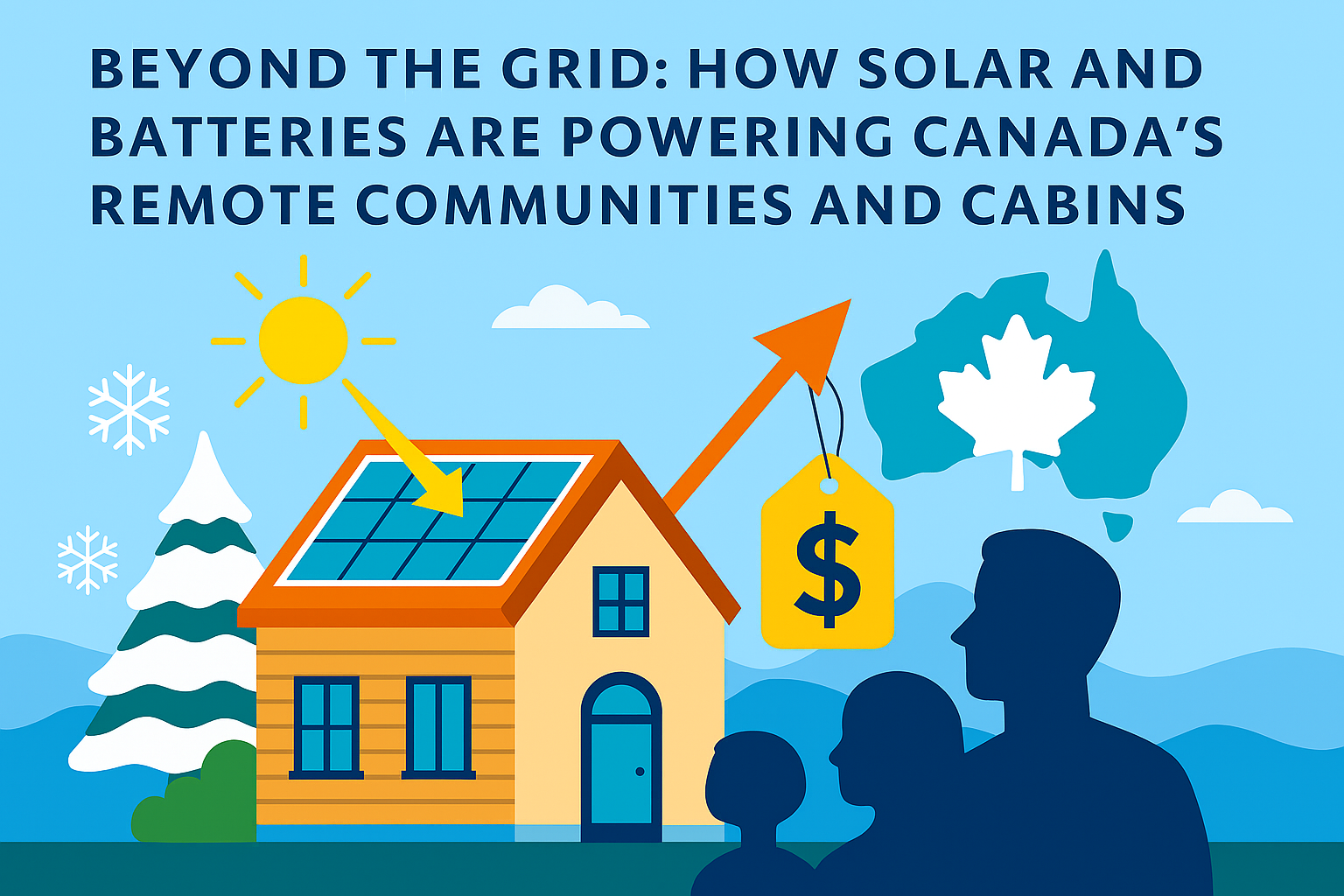Table of Contents
Canada’s vast geography is both its strength and its challenge. Stretching across rugged mountains, frozen tundra, and isolated forests, many Canadian communities and cabins remain far from traditional power grids. For decades, these off-grid locations relied heavily on diesel generators—noisy, costly, and environmentally damaging.
Today, a new chapter is unfolding: solar-plus-battery systems are transforming how remote communities and recreational cabins access electricity. From Indigenous villages in the North to small cabins deep in the Canadian Shield, renewable energy is replacing diesel, providing cleaner, more reliable, and more sustainable power.
The Shift from Diesel to Solar
Diesel has long been the default option for off-grid power. While dependable, it carries steep costs:
- Logistical challenges: Fuel delivery in remote areas requires trucks, barges, or even planes.
- High expenses: Rising fuel costs strain community budgets.
- Environmental impact: Diesel use contributes to carbon emissions, pollution, and fuel spills.
- Noise and disruption: Generators are loud and often run 24/7.
Solar-plus-storage systems offer a viable alternative. With declining solar costs and advances in battery technology, communities can now generate and store their own energy—silently, sustainably, and independently.
Why Solar Works in Canada’s Remote Regions
Many assume Canada’s colder, snowy climate makes solar impractical. In reality, the opposite is true. As discussed in our guide to solar in snowy climates, solar panels often perform better in cold weather, and snow’s reflective properties can increase energy capture.
Key advantages for remote regions include:
- Energy independence: Communities reduce reliance on fuel shipments.
- Lower long-term costs: After installation, solar power is essentially free.
- Silent operation: Panels and batteries provide quiet power compared to generators.
- Resilience: Solar arrays paired with batteries ensure continuous electricity, even during storms or supply disruptions.
Indigenous Communities Leading the Way
Across Northern Canada, Indigenous communities are pioneering solar-plus-storage solutions. For example, hybrid systems combining solar with small-scale batteries are already reducing diesel dependency in Nunavut, Yukon, and northern Ontario. These projects do more than supply energy—they build local capacity, create jobs, and strengthen community resilience.
By tailoring systems to local needs, communities are reclaiming control of their energy future and cutting greenhouse gas emissions.
Recreational Cabins: A Growing Market
Beyond large communities, thousands of recreational cabins across the Canadian Shield, BC backcountry, and the Prairies are embracing solar-plus-storage. Cabin owners are discovering that a properly designed system can:
- Power lights, appliances, and communication devices year-round.
- Eliminate the hassle of transporting fuel.
- Reduce noise, creating a peaceful wilderness experience.
What once required noisy generators now comes from a clean, silent solar array backed by modern lithium-ion batteries.
Technical Design Considerations for Harsh Environments
Designing solar-plus-storage systems for Canada’s remote environments is not one-size-fits-all. These systems face extreme cold, heavy snow loads, and difficult installation conditions. That’s why proper engineering and permitting are critical.
1. Engineering for Snow and Wind Loads
Systems must be designed to withstand Canadian winters. An engineering stamp ensures panels and racking structures meet provincial building codes and can handle snow accumulation and high winds.
2. Battery Performance in Low Temperatures
Lithium-ion batteries must be housed in insulated, heated enclosures to maintain efficiency. Proper sizing ensures enough storage for extended cloudy periods.
3. Optimized Solar Angles
Panels in snowy regions should be tilted steeply to shed snow quickly and capture low-angle winter sunlight. Services like solar permit design ensure compliance with local regulations while optimizing performance.
4. Hybrid Configurations
Some communities pair solar-plus-storage with small backup generators for redundancy. Careful integration ensures seamless transitions between energy sources.
5. Durability and Logistics
Components must be rugged, easy to transport, and simple to maintain in remote areas where replacement parts aren’t easily available.
The Human Impact
Beyond technical benefits, the transition to solar-plus-storage has profound social and cultural impacts:
- Lower energy bills free up funds for health, education, and infrastructure.
- Cleaner air and quieter nights improve community well-being.
- Energy sovereignty allows Indigenous peoples to make decisions aligned with their values and traditions.
- Sustainable tourism and recreation benefit from cabins and lodges that market themselves as eco-friendly and off-grid capable.
This transformation goes far beyond technology—it’s about independence, dignity, and respect for the land.
Supporting the Transition: Professional Services Matter
For solar in remote Canada, success depends on strong design and compliance. At One Place Solar, we specialize in:
- Engineering Stamps for structural and safety assurance.
- Solar Permit Design tailored to regional building codes.
- Preliminary Solar Design to optimize system layout for snowy, remote environments.
- Sales Proposals that make the case for financing high-value projects.
These services ensure every off-grid solar project is safe, compliant, and built to last.
The Road Ahead
Canada’s energy future is increasingly decentralized. While major cities push for grid-connected solar, remote communities are charting their own path with independent, resilient systems. Solar-plus-battery adoption is accelerating because it makes both economic and environmental sense.
As diesel reliance fades, solar installations will continue to spread across the North, the Prairies, and the wilderness cabins of the Canadian Shield. With proper planning and design, Canada’s harshest environments will become testaments to renewable energy’s strength.
Conclusion: A Brighter Future Off the Grid
The myth that solar can’t work in remote, snowy regions is being dismantled by real-world results. From Indigenous communities reclaiming energy sovereignty to families enjoying silent nights at their off-grid cabins, solar-plus-storage is changing lives across Canada.
The combination of durability, independence, and sustainability makes it clear: the future of Canada’s remote power is renewable.
📩 Ready to bring solar to your off-grid project? Connect with the experts at One Place Solar today.
👉 Contact Us to design a system built for Canada’s toughest conditions.
